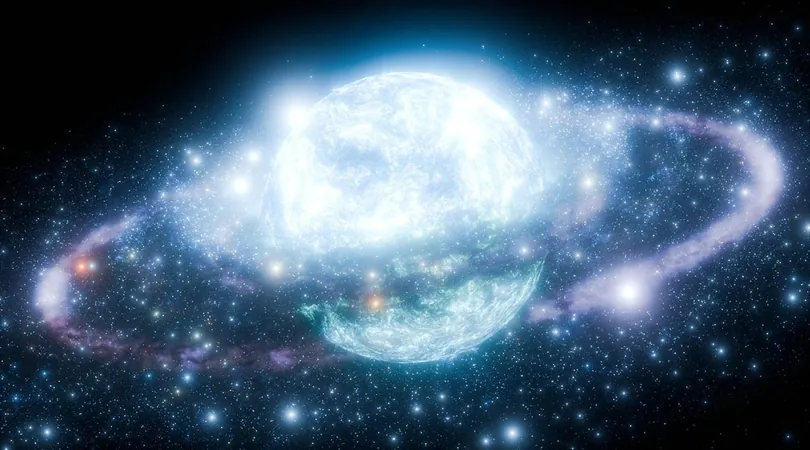
Unlocking the Secrets of Dark Matter: Neutron Stars and Axion Clouds
2024-11-11
Author: Sophie
Unlocking the Secrets of Dark Matter: Neutron Stars and Axion Clouds
In a groundbreaking development, scientists are proposing a revolutionary method to detect dark matter by focusing on the unusual radio signals emitted from neutron stars—the dense remnants of colossal stars that shrink to a diameter of just about 10 kilometers while packing in several times the mass of our Sun.
Dark matter, which is believed to comprise roughly 85% of the universe's total matter, has remained an enigma as it has never been directly observed. Its existence is inferred from its gravitational influence on visible matter across vast cosmic distances. Unfortunately, laboratory attempts to detect dark matter have repeatedly met with failure.
Recent research suggests that dark matter may accumulate in dense clouds surrounding neutron stars, thereby making it more detectable. This hypothesis hinges on the existence of ultralight particles known as axions, which are theorized to be vastly lighter than electrons. Their properties align with the behaviors expected of dark matter, such as forming halos around galaxies.
Neutron Stars as Factories for Axions
In a prior study, researchers emphasized that the intense electromagnetic fields surrounding neutron stars—created when interstellar gas is drawn in by the star's powerful gravity—could serve as breeding grounds for axions. Under extreme conditions, photons (the fundamental units of light) might naturally convert into axions, generating the potential for detectable signals.
In their latest paper published in *Physical Review X*, the scientists conducted an in-depth analysis of axions once they become gravitationally trapped by neutron stars. This research aimed to determine whether these axions could produce the distinct signals—like X-rays and radio waves—that could be observed with existing telescopes.
One intriguing aspect of this study is the proposal to search for these signals originating from the magnetospheres of neutron stars, regions where extraordinarily strong magnetic fields enhance the interaction between axions and electromagnetism, leading to unique observational signatures.
The Formation and Density of Axion Clouds
While the precise characteristics of axions, including their mass and electromagnetic interaction strength, remain uncertain, the researchers explored a broad spectrum of these parameters. Their analysis examined the life cycles of ten neutron stars, revealing that the density of axions—hence dark matter—around these stars could nearly match that of liquid water. This is astonishing when considering the typical vacuum of space, which averages only one atom per cubic meter.
Such high density implies an efficient conversion of axions into light photons, potentially within the detection capabilities of modern telescopes like the Low-Frequency Array, the Murchison Widefield Array, and the Green Bank Telescope.
Toward a Dark Matter Breakthrough
The scientists noted that, for typical neutron stars in their study, the density of axions near the star's surface could surpass the local dark matter density by more than 20 orders of magnitude, sustained over significant portions of the neutron star's lifespan. They underscored the implication of axion clouds producing sharp spectral lines at radio frequencies, which could be captured by current radio telescopes.
While successfully detecting axions through this method would represent a monumental achievement, the researchers stress that the pursuit itself is vital. Even failing to find direct evidence of axions would help refine our understanding of their mass and how they interact with electromagnetic fields, leading to improved theoretical models.
Moving forward, the need for extensive studies around neutron star magnetospheres and how the surrounding plasma behaves is crucial. Investigating the dynamics between axions and electromagnetic fields will further illuminate the radio waves potentially emitted due to axion clouds.
With continued research and the advancement of contemporary telescope technology, unraveling the mystery surrounding dark matter may soon be within reach. In the quest to understand the universe, these neutron stars could very well be the keys to unlocking one of the greatest cosmic puzzles of our time.









 Brasil (PT)
Brasil (PT)
 Canada (EN)
Canada (EN)
 Chile (ES)
Chile (ES)
 Česko (CS)
Česko (CS)
 대한민국 (KO)
대한민국 (KO)
 España (ES)
España (ES)
 France (FR)
France (FR)
 Hong Kong (EN)
Hong Kong (EN)
 Italia (IT)
Italia (IT)
 日本 (JA)
日本 (JA)
 Magyarország (HU)
Magyarország (HU)
 Norge (NO)
Norge (NO)
 Polska (PL)
Polska (PL)
 Schweiz (DE)
Schweiz (DE)
 Singapore (EN)
Singapore (EN)
 Sverige (SV)
Sverige (SV)
 Suomi (FI)
Suomi (FI)
 Türkiye (TR)
Türkiye (TR)
 الإمارات العربية المتحدة (AR)
الإمارات العربية المتحدة (AR)